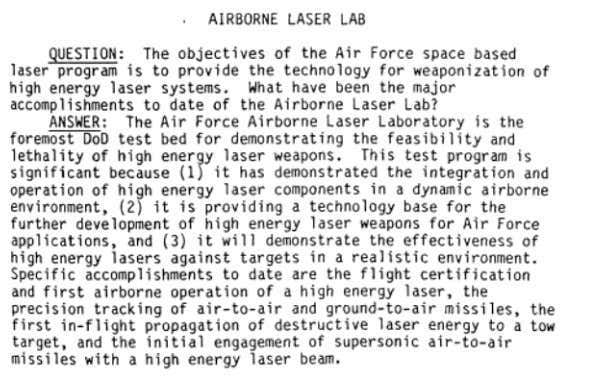Spazio: ultima frontiera. Credere che si sia soli nell'universo è come credere che la Terra sia piatta. Come disse l'astrofisico Labeque al palazzo dell'UNESCO, durante il congresso mondiale del SETI di Parigi del Settembre 2008, " SOMETHING IS HERE", "Qualcosa è qui", e I TEMPI SONO MATURI per farsene una ragione. La CIA, l'FBI, la NSA, il Pentagono, e non solo, lo hanno confermato!
Statistiche
Sunday, May 30, 2021
Saturday, May 29, 2021
Mysterious Black Towed Target Was Built To Support Airborne Laser Tests ( The War Zone )
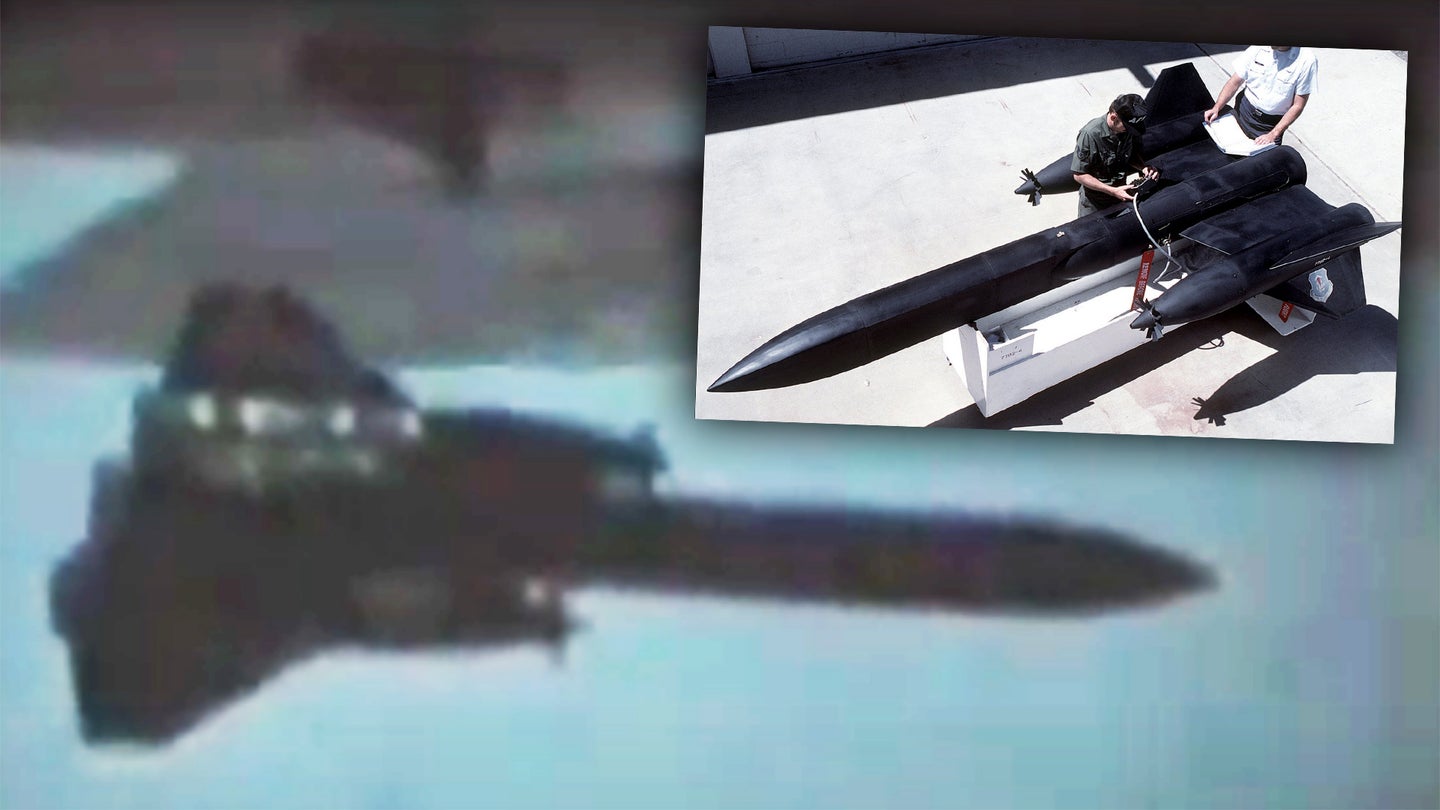
We finally know for sure what the SR-71-looking, small, and sleek craft photographed at Kirtland AFB was intended to be used for.
A month ago, we published a photo of a strange, SR-71-looking drone or target-like craft that existed at Kirtland Air Force Base in New Mexico in the early 1980s. The goal was to find out exactly what this mysterious system was and why it existed. We subsequently reported on a trail of information about the development of the system and the fact that it was a high-speed towable target that was developed in the mid-1970s, a version of which held the moniker TDU-X. We also saw some indications that it may have been used, at least in part, to assist in developing and testing of the Airborne Laser Laboratory (ALL), which was also based out of Kirtland at the time. Now we have the definitive story on exactly what this was and what it was used for at the sprawling New Mexican base.
The answer to the final part of this mystery comes to us from Dr. Darren Raspa, a historian at the Air Force Research Laboratory's (AFRL) Phillips Research Site at Kirtland. Following our series on the mystery craft, and apparently unrelated to our inquiries to the AFRL on the matter, Raspa dug into the archives at the facility to find an answer, here was his email to us after he made his discovery:
Mr. Rogoway, et al.—
After reading your latest piece on this from 7 May, I was intrigued by the reference to the Airborne Laser Lab [ALL] program, which my archive houses the majority of the document repository. What you see in the photograph is a tow target used in testing the high-power beam of the ALL in flight. These tow targets allowed ALL pilots and crew to refine their aiming, point, and tracking of an aerial target, such as would be required when taking down a strategic missile, which was the ALL’s mission. The pictured tow target is called the HEL-X, and was used briefly in testing the ALL APT system and was deployed from an F-4. HEL-X was abandoned as a tow target because when it was reeled back in, at about 10 feet from the aircraft it would go into wild oscillations. The attached footage I’ve recovered illustrates all of the above and clearly shows the TDU indicated in your mystery photograph.
Hopefully this solves the mystery!
My best to you,
-Darren
Dr. Darren A. Raspa
Historian
Air Force Research Laboratory
Phillips Research Site
Kirtland AFB, NM
The video of an F-4 deploying and retracting the HEL-X that Dr. Raspa sent is excellent. Check it out below:
In our previous piece, we thought the towed target in question may have been related to ALL test work at Kirtland, stating:
In the 1970s and 1980s, AFWL was also involved in directed energy work, particularly lasers, making good use of its proximity to the Sandia Optical Range, also in New Mexico, which was subsequently renamed the Starfire Range. With this in mind, it's interesting to note that a written response from the Pentagon to a question from the Senate Appropriations Committee regarding the Fiscal Year 1983 defense budget request mentions that the "first in-flight propagation of destructive laser energy to a tow target" was among the "specific accomplishments to date" for the NKC-135A Airborne Laser Laboratory (ALL) aircraft.
The Air Force conducted various tests involving the NKC-135A ALL aircraft, which was fitted with a 10.6-micrometer carbon dioxide laser, between 1975 and 1984. That testing also including shooting down air-to-air missiles, including AIM-9 Sidewinders, and target drones. It's certainly possible that Kirtland also used later TDU-X variants, or more substantial derivatives of that design, to support its airborne laser work.
A written response from the Pentagon to a question from Senate Appropriations Committee regarding the Airborne Laser Laboratory program in relation to its Fiscal Year 1983 budget request.
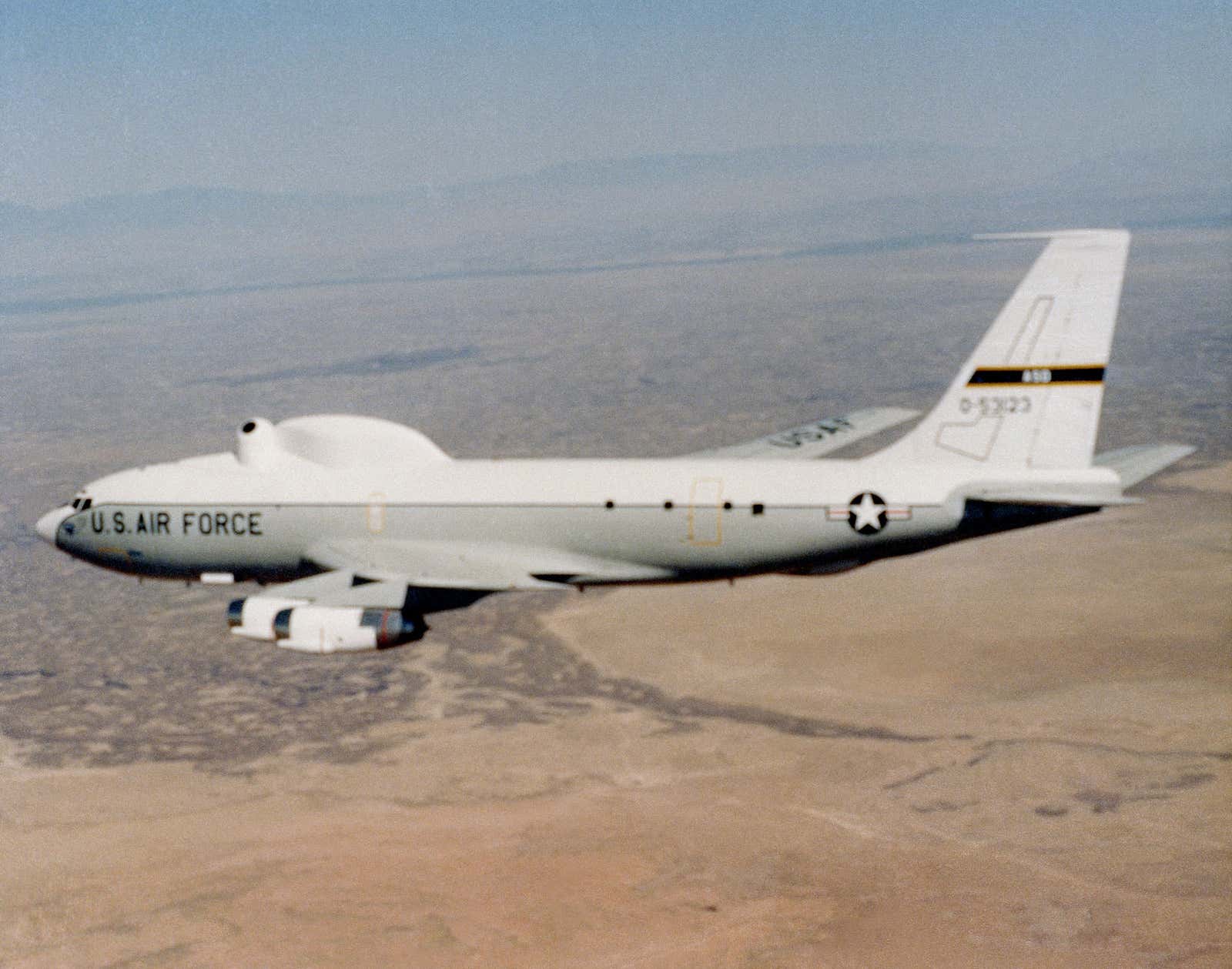
NKC-135 Airborne Laser Laboratory
Now we know this was indeed the intention for these targets, although under the HEL-X designation.
So, there you have it. These unique craft were tied to America's fledgling airborne laser ambitions of the era.
Special thanks to Dr. Darren Raspa for helping us close the case on this unique little facet of military aviation history.
Where to Hunt for UFOs in Massachusetts ( Boston Magazine )

Hoping to catch a glimpse of alien life for yourself? These Massachusetts hot spots are good places to start.
From day trips to weekend getaways, our biweekly Traveler newsletter shows you the best of New England and beyond.
Wachusett Mountain photo via Getty/danlogan
The truth is out there. In fact, it may be right in your backyard.
For many years now, aliens and UFOs have had a prominent place in the American psyche, with a dedicated community of researchers, historians, everyday hobbyists, and even government employees watching the skies for signs of life from outer space. But now, as videos of unexplained aerial phenomena have been verified by the U.S. military, given serious consideration in venues like the New York Times and 60 Minutes, and a Congressional hearing on the matter set for June, the previously skeptical masses are giving the concept of alien visitors a second look.
So where might a curious ufologist in training get started around here if they were eager to spot an unidentified object in the skies for themselves? As it turns out, there may be ample opportunities in New England, as the region is crawling with alleged sightings of alien life. Just ask the Mutual UFO Network, which calls itself the “world’s oldest and largest civilian UFO investigation & research organization,” and which has added scores of Massachusetts-based incidents to its UFO Stalker tool, complete with descriptions, and sometimes purported photo and video evidence.
MUFON’s work has showed that reports of mysterious encounters can spring up just about anywhere, at any time, but seasoned experts have identified several hot spots.
Before you set off on a UFO hunt of your own, some tips: For one, says Susan McNeill Spuhler, organizer of the Greater New England UFO Conference, the same principles apply to UFO-spotting as stargazing. You’ll want to find a public area where light pollution is low, in order to have unobstructed views of the night sky. Low cloud cover is a plus, as is a new moon. Even if you don’t get a first-hand view of a UFO, you’ll at least enjoy a truly star-filled evening, an experience that’s all too hard to come by these days in light-polluted Greater Boston.
Additionally, she says, do not bring laser pointers on your journey in an effort to attract the attention of alien life, as doing so could put airline pilots in danger.
With that in mind, here are some areas of interest to get you started:
Hanscom Air Force Base
Considering the aliens’ apparent fascination with the American armed forces, Hanscom is as good a place as any to get started. In fact, if you turn your eyes skyward near the base and see something unusual, you wouldn’t be the first person to conclude you’d encountered otherworldly visitors. MUFON’s database includes multiple accounts of sightings in that area. One Boston reader wrote in a few years back to report “a glowing orb moving up and down in the sky.”
Monsterland
For many years, a chunk of the Leominster State Forest has been the stuff of legend, earning the nickname Monsterland for the high concentration of eerie incidents reported there. Strange encounters believed to have taken place in the roughly five-mile-wide expanse, many of them documented by local author and occasional TV star Ronny Le Blanc, run the gamut, from brushes with Bigfoot to, once again, orbs that glow. UFOs have always been included in that mysterious mix, particularly back in the late 1960s, when, as Le Blanc recently told the Telegram & Gazette, the region was hit with a “a huge UFO wave,” and that all throughout Central Massachusetts, “[p]eople were seeing UFOs over ponds and lakes and there was a lady in Fitchburg saying there are UFOs coming out of the reservoir.” If you do spot anything out there, be sure to let Le Blanc know, and you might just end up in his next book.
The truth is out there. In fact, it may be right in your backyard.
For many years now, aliens and UFOs have had a prominent place in the American psyche, with a dedicated community of researchers, historians, everyday hobbyists, and even government employees watching the skies for signs of life from outer space. But now, as videos of unexplained aerial phenomena have been verified by the U.S. military, given serious consideration in venues like the New York Times and 60 Minutes, and a Congressional hearing on the matter set for June, the previously skeptical masses are giving the concept of alien visitors a second look.
So where might a curious ufologist in training get started around here if they were eager to spot an unidentified object in the skies for themselves? As it turns out, there may be ample opportunities in New England, as the region is crawling with alleged sightings of alien life. Just ask the Mutual UFO Network, which calls itself the “world’s oldest and largest civilian UFO investigation & research organization,” and which has added scores of Massachusetts-based incidents to its UFO Stalker tool, complete with descriptions, and sometimes purported photo and video evidence.
MUFON’s work has showed that reports of mysterious encounters can spring up just about anywhere, at any time, but seasoned experts have identified several hot spots.
Before you set off on a UFO hunt of your own, some tips: For one, says Susan McNeill Spuhler, organizer of the Greater New England UFO Conference, the same principles apply to UFO-spotting as stargazing. You’ll want to find a public area where light pollution is low, in order to have unobstructed views of the night sky. Low cloud cover is a plus, as is a new moon. Even if you don’t get a first-hand view of a UFO, you’ll at least enjoy a truly star-filled evening, an experience that’s all too hard to come by these days in light-polluted Greater Boston.
Additionally, she says, do not bring laser pointers on your journey in an effort to attract the attention of alien life, as doing so could put airline pilots in danger.
With that in mind, here are some areas of interest to get you started:
Hanscom Air Force Base
Considering the aliens’ apparent fascination with the American armed forces, Hanscom is as good a place as any to get started. In fact, if you turn your eyes skyward near the base and see something unusual, you wouldn’t be the first person to conclude you’d encountered otherworldly visitors. MUFON’s database includes multiple accounts of sightings in that area. One Boston reader wrote in a few years back to report “a glowing orb moving up and down in the sky.”
Monsterland
For many years, a chunk of the Leominster State Forest has been the stuff of legend, earning the nickname Monsterland for the high concentration of eerie incidents reported there. Strange encounters believed to have taken place in the roughly five-mile-wide expanse, many of them documented by local author and occasional TV star Ronny Le Blanc, run the gamut, from brushes with Bigfoot to, once again, orbs that glow. UFOs have always been included in that mysterious mix, particularly back in the late 1960s, when, as Le Blanc recently told the Telegram & Gazette, the region was hit with a “a huge UFO wave,” and that all throughout Central Massachusetts, “[p]eople were seeing UFOs over ponds and lakes and there was a lady in Fitchburg saying there are UFOs coming out of the reservoir.” If you do spot anything out there, be sure to let Le Blanc know, and you might just end up in his next book.

Covered Bridge Ln., where Thom Reed and his family experienced their
encounter. Photo via Wikimedia Commons / Photo via Wikimedia Commons
Thanks to the controversy surrounding this particular monument, you may have heard this tale before. Sheffield’s Thomas Reed claims that, back in 1969 when he was 9 years old, he and his family were abducted in an alien spacecraft. Reed was not content to let this become simply a tale he told at parties, so as an adult in 2015 he decided to commemorate the incident with a large stone plaque. A dispute between Reed and the town about the monument’s placement on what officials say is public property sadly resulted in it being confiscated in 2019. Still, giant monument or no giant monument, Massachusetts UFO history went down at this site. It may be worth the trip regardless, as it’s also home to a delightful covered bridge.
Exeter, NH
Just over the border in New Hampshire, you’ll find the site of one of the most bedeviling purported alien encounters in history, a series of brushes with unidentified flying objects in 1965 that has come to be known simply as the “Incident at Exeter.” Police at the time said multiple witnesses came forward to say they’d seen, or been chased by, something unusual in the sky. Several police officers themselves claim to have seen it, and an official report authored by the Air Force indicates the government has never been able to offer an explanation for the events. As a result, the Incident has captivated true believers and skeptics alike for more than half a century. So maybe the aliens will visit these now-famous grounds once again. Or maybe they’ll make an appearance for the crowds gathered at the rescheduled Exeter UFO Festival, which had been set to mark the event’s 55th anniversary last year.
Spencer Buell
UFO intelligence report due next month after military sightings, including off Virginia coast ( abc8NEWS )

RICHMOND, Va (WRIC) — An intelligence report on Unidentified Aerial Phenomenon, commonly referred to as UFOs, is due to Congress next month, weeks after widespread renewed interest in the unexplained sightings.
Gone are the days of the US government scoffing at the idea of UFOs. Military personnel increasingly say they have seen the moving images in the sky; prompting a report ordered by Congress.
“Look at that thing, it’s rotating,” one service member said when looking at a unidentified object flying off the Florida coast in 2015; the Pentagon labeled the sighting as “Gimbal.”
US military video and radar have documented the phenomenon and some video taken in recent years has been released by the Department of Defense.
“Oh my gosh, man. Wow! What is that man?” Look at it fly,” another service member said of the ‘Go Fast’ sighting off the Atlantic Coast.
U.S. lawmakers like Virginia Senator Mark Warner, chairman of the Senate Intelligence Committee, want answers.
In a statement Friday, Sen. Warner said “Virginia is home to one of the largest naval bases in the world and to thousands of service members. While the report has not yet been made public, it is my hope that it can provide answers if our naval pilots encounter interference performing their duties. Addressing any risks that can endanger their lives whether on a mission or during training must remain a priority.”
Associate Professor of Physics at the University of Richmond Jack Singal says it’s important to separate conspiracy from unidentified aerial phenomenon.
“Extraordinary claims require extraordinary evidence…” Singal said. “The conspiracy theories come in when we say things like, ‘well, aliens have visited earth and the government is hiding the evidence of the alien bodies themselves or direct spacecraft or real encounters with people who’ve been abducted.'” However, Singal said the potential for other intelligent life to exist in the galaxy is a possibility
“This kind of interstellar space travel would be something that would take thousands of millions of years. And so we would have to imagine a civilization that is much more advanced than ours,” he said.
“One of the things that has changed–I received a classified briefing on this so I can only give you the top line–is that the military has seen enough things where they are actually now encouraging pilots to report. If there are objects flying over military installations, that could pose a security threat” Sen. Warner said last July.
The U.S. UAP intelligence report is due next month; no telling what it may detail.
Ben Dennis
UFO whistleblower says Pentagon tried to silence him ( Changing America )
The Pentagon whistleblower has filed a complaint accusing his former agency of “malicious activities, coordinated disinformation, professional misconduct, whistleblower reprisal, and explicit threats.”
A Pentagon whistleblower who has been outspoken about UFOs has filed a complaint with the inspector general accusing his former agency of “malicious activities, coordinated disinformation, professional misconduct, whistleblower reprisal and explicit threats,” according to Politico.
Luis Elizondo, who was head of the Pentagon’s discontinued Advanced Aerospace Threat Identification Program, claims a senior-level official even threatened to call him “crazy” and wage a disinformation campaign to discredit him.
“I
responded … by telling him that he can take any action he thinks is
prudently necessary, but that I was not mentally impaired, nor have I
ever violated my security oath,” Elizondo wrote, adding that the
Pentagon’s press team even got involved.
“Several internet bloggers were notified … that I had no duties regarding AATIP and that AATIP did not involve the study of UAPs,” Elizondo said. “As a result, the bloggers began to disseminate reporting, accusing me of being a fabricator.”
Elizondo said he felt the need to become a whistleblower out of fear and concern for the country.
“I became alarmed by the frequency and duration of UAP activity in and around controlled U.S. airspace,” he said. “The instances seemed more provocative, and during one instance, they came within feet of a U.S. fighter aircraft.”
A spokesperson for the Defense Department Inspector General's Office declined to comment.
“I cannot speculate or deliberate about complaints that our office may have received,” Dwrena Allen told Politico. “I certainly cannot confirm or deny the existence of an investigation to the same.”
Elizondo’s legal team said it would be meeting with investigators in June.
Next month, Congress will receive a report on unidentified aerial phenomena, or UAPs, evolving to become a possible national security threat.
Jenna Romaine
Ma come sono questi alieni? Davvero verdi con gli indici lunghi? ( La Stampa )
Luciana Littizzetto
Eh certo. Dopo il Covid, il razzo cinese e il reattore di Cernobyl potevamo farci mancare un UFO? Certo che no.
Il Pentagono ha confermato
il video: è proprio un UFO. Io l’ho visto, molto affascinante per
carità, peccato non si capisca una mazza. Sembra un’ecografia. Ma
scusami. Su Marte abbiamo: i Curiosity, gli Ability, i Furbology,
riusciamo a contare i granelli di sabbia e i segni delle curve dei
pneumatici del Badolity e non riusciamo a vedere dentro ste navicelle se
gli extraterrestri hanno i nasi a forma di pipa e sono verdi perché
devono ancora maturare? Poi UFO, oggetto non identificato, può essere
qualsiasi cosa. Da un faretto di una Twingo partito a una che ha
sbagliato il parcheggio, a un disco volante della galassia di Suca. E
soprattutto: come è possibile che noi non abbiamo mai visto la faccia di
questi qua? Ce li immaginiamo. Qualcuno dice che sono bassi, verdi, e
con gli indici lunghi. Ma magari non è così. Magari il cosmo è abitato
da vegetali intelligenti, tipo patate con l’occhio furbo o esseri tutta
testa che rotolano invece che camminare. Magari lo spazio è popolato da
marziani lunghi come due Pippi Baudi uno sull’altro e con la lisca al
posto della spina dorsale. E poi: di che sesso saranno gli alieni?
Magari sono maschi i giorni dispari e femmine i giorni pari. Pillon
sclera.
Comunque, secondo me dobbiamo stare sereni perché se
erano venuti sulla Terra per cercare una forma d’intelligenza, non li
vedremo mai più. —
Luciana Littizzetto
Ufo, Podesta torna alla carica. Dall’Area 51 alla Casa Bianca ( f! )

John Podesta
Negli Usa si passa dallo sbeffeggiare chi parlava di avvistamenti ufo a voler studiare attentamente i fenomeni. Oggi John Podesta, consigliere di due presidenti e storico stratega del Partito democratico (nonché appassionato di ufo da decenni) propone di creare un ufficio apposito alla Casa Bianca
Gli ufo sono tornati prepotentemente di moda, anche grazie alle ammissioni del Pentagono, il corpus crescente di testimonianze e video autenticati dalle autorità americane e un rapporto governativo in materia, in uscita a giugno. Ora lo storico stratega del Partito democratico John Podesta, capo di gabinetto di Bill Clinton, consigliere senior di Barack Obama e Hillary Clinton, vuole creare alla Casa Bianca una squadra ad hoc per lo studio degli oggetti volanti non identificati.
Podesta è affascinato dagli ufo almeno da più di vent’anni, durante i quali ha esortato il governo statunitense a essere più trasparente sugli avvistamenti. Ora il momento è propizio: con la crescente attenzione mediatica, sono in molti a trattare l’argomento più seriamente – e preoccuparsi della possibilità che qualcuno, là fuori, possa avere accesso a una tecnologia superiore. Il senatore repubblicano Marco Rubio è in prima linea nella battaglia per far desecretare il rapporto che il direttore della sicurezza nazionale di Joe Biden dovrà far arrivare al Congresso il mese prossimo.
L’idea di Podesta è ampliare l’Ufficio per le Politiche di Scienza e Tecnologia (Ostp), un organo della Casa Bianca, aggiungendo una sezione dedita allo studio degli Ufo. Questa potrebbe dedicarsi a recuperare tutto il materiale necessario da tutte le agenzie governative federali, per poi condividerle col pubblico. “[All’Ostp] sono più abituati a muoversi in un ambiente open source, occuparsi di informazioni scientifiche di dominio pubblico e a discutere con la comunità scientifica rispetto a, che so, i programmi segreti al Pentagono”, ha detto a Politico.
Ma il rapporto di giugno potrebbe non vedere la luce nei tempi previsti perché i servizi militari e di intelligence starebbero puntando i piedi. Ieri la portavoce della Casa Bianca Jen Psaki ha fatto sapere che le relative squadre di governo erano “a conoscenza” della necessità di produrre il rapporto (come da legge passata dall’amministrazione di Donald Trump) e ci stavano lavorando. Psaki ha anche avvertito che la decisione finale sul rilascio del rapporto integrale sarebbe comunque rimasta in capo all’Ufficio del direttore dell’intelligence nazionale (Odni).
Sembrano passati i tempi in cui chiunque parlasse di ufo veniva trattato con scetticismo. A marzo l’ex direttore dell’intelligence nazionale sotto Trump, John Ratcliffe, fece ingolosire gli spettatori di Fox News alludendo al rapporto e dicendo che “ci sono stati molti più avvistamenti di quanti ne siano stati resi pubblici”. Podesta non può che esserne contento, dato che un tempo associarsi alla materia poteva rovinare una carriera. “Non è più così, chiaramente, ed è una cosa buona”, ha detto a Politico.
Nel 1998 il portavoce di Clinton disse al Washington Post che Podesta, notoriamente, chiamava l’Air Force per chiedere cosa avvenisse nell’Area 51. “Mi intriga quanto il governo si sia rifiutato di vuotare il sacco riguardo alle cose che ha fatto in passato”, ha confessato Podesta. Oggi mantiene la stessa ironica compostezza: “non mi aspetto di essere strappato via dalla macchina e trasportato da un raggio in una nave spaziale assieme a mia moglie”, ha detto a Politico, “è che mi piace conoscere cosa sa il governo, e credo che il pubblico abbia il diritto di sapere”.
Otto Lanzavecchia
Ufo, i nuovi video. Nove oggetti non identificati avvistati sopra la nave Omaha ( Il Giorno )

Pubblicati su Twitter da un regista americano dopo essere stati desecretati dal Pentagono
E' ormai Ufo mania negli Stati Uniti. Non passa giorno senza che si venga a conoscenza di nuovi avvistamenti. Il regista Jeremy Corbell, che aveva diffuso filmati di presunti oggetti non identificati che volevano sopra la portaerei americana Omaha al largo della costa della California nel 2019, ha pubblicato sul suo account Twitter una serie di nuovi clip.
"Questi sono dati elettro-ottici che dimostrano una serie di eventi Ufo significativi in un'area al largo di San Diego", ha twittato Corbell, spiegando che il video è stato girato nel Combat Information Center della nave il 15 luglio 2019. Il regista li ha pubblicati dopo che sono stati desecretati dal Pentagono. Nelle immagini che sono state rese pubbliche si vedono marinai a bordo dell'Omaha che osservano fino a nove Ufo - o presunti tali - che girano sulla nave a tutta velocità. "Santo cielo, stanno andando veloci", si sente dire uno di loro.
Il ricorso dell'ex ufficiale
Intanto, come ogni mistero che si rispetti, spunta anche un cotè polemico, fra accuse e controaccuse. E' il turno dell'ex ufficiale dell'intelligence militare che ha rivelato l'esistenza di un programma segreto sugli avvistamenti degli Ufo dire la sua. Lue Elizondo, questo il suo nome, accusa il Pentagono di condurre una campagna per screditarlo, descrivendolo come "un pazzo". Le sue dichiarazioni sono tratte da documenti allegati al suo ricorso rivolto all'ispettore generale del dipartimento della Difesa Usa. Elizondo, specialista del controspionaggio che dal 2008 ha lavorato al programma investigativo riguardante gli avvistamenti di "oggetti volanti non identificati", ha avuto già diversi incontri con gli investigatori. I suoi legali sostengono che il loro cliente afferma che vi sono persone al Pentagono che "lo stanno attaccando, mentendo su di lui in pubblico, usando le loro cariche per discreditarlo ed impedirgli di trovare altri posti di lavoro". La notizia del ricorso arriva mentre è attesa nelle prossime settimane la consegna al Congresso del rapporto non classificato di National Intelligence e Pentagono sugli Ufo e la strategia del governo per indagare gli avvistamenti.
Thursday, May 27, 2021
How Raytheon Is Delivering Laser Beams To The Battlefield ( The War Zone )
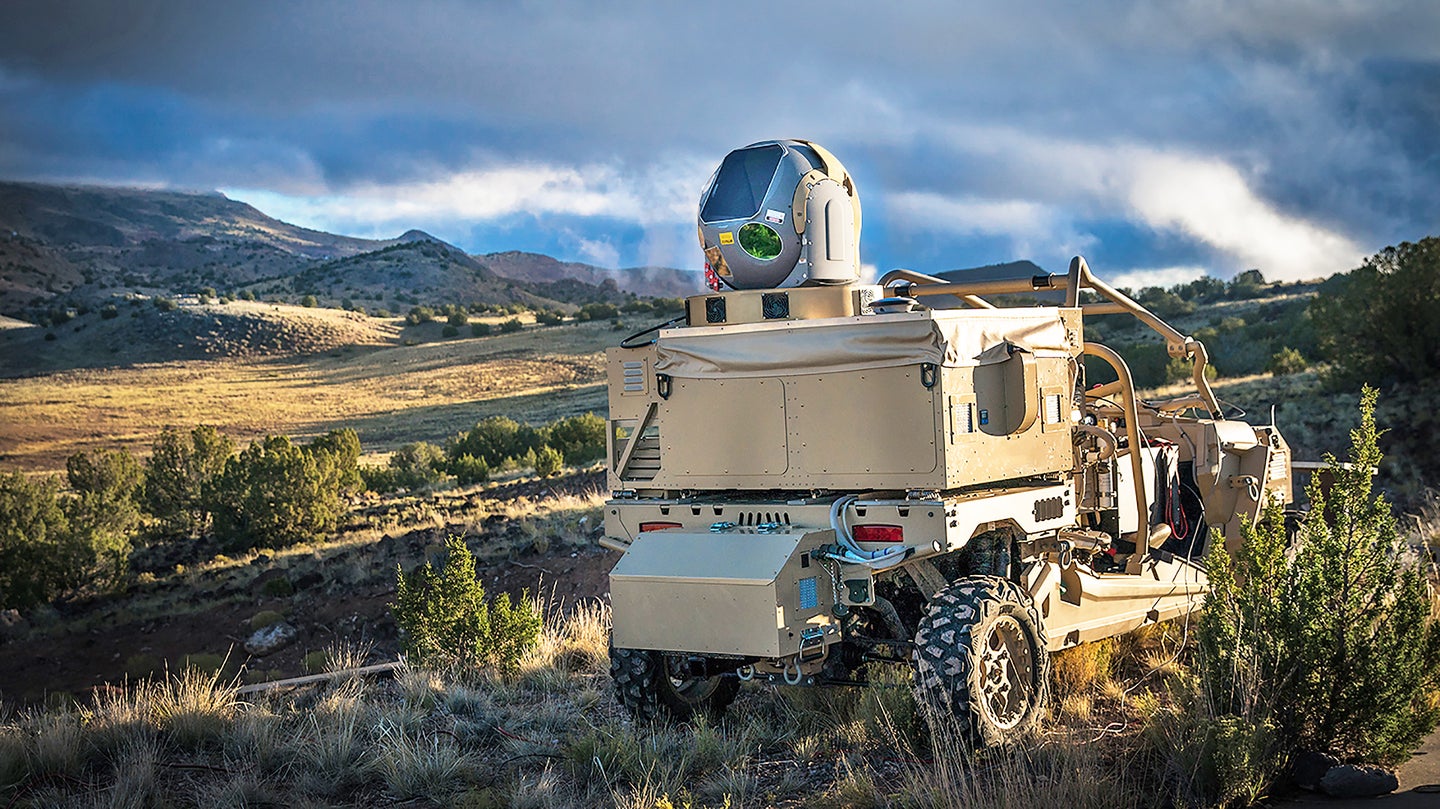
We talk with one of the company's top minds about its buggy-borne High Energy Laser Weapon System and the future of directed energy in combat.
Modern Western militaries face a number of extremely difficult problems as they attempt to modernize rapidly aging armed forces’ equipment and tactics to confront rising threats. For the United States in particular, the services must field capabilities able to deter and if necessary, defeat China and Russia, while also maintaining an ability to rapidly commit forces to confront rogue state threats such as North Korea and Iran. On top of that, they must continue to service global commitments in a host of lower intensity conflicts and contingency scenarios. In trying to equip and sustain forces able to cover this extremely broad range of mission sets, two problems, in particular, are commonly faced in all of them.
This paid article was produced by the Brookline Media Advertising Content Team in partnership with Raytheon.
The first of these problems is inadequate numbers of advanced munitions to service more than a small portion of the required target sets in many potential conflict scenarios. One aspect of this is adversaries from peer states to insurgent groups fielding capabilities which threaten to overwhelm existing defense systems. These threats range from adapted commercial unmanned aerial systems (UAS) to loitering munitions to cheap and numerous indirect fire capabilities. In most cases, the military has high-end missile-based air defense systems theoretically capable of defeating these threats individually. However, magazine limitations means that the sheer number of relatively cheap hostile systems which can be brought to bear threatens to overwhelm these advanced defense systems by weight of numbers.
The second linked problem is that the US military is consistently on the wrong side of the cost curve. Even where sufficient stocks of advanced munitions can be fielded, using missiles that cost hundreds of thousands or even millions of dollars to destroy threats which often cost a few thousand dollars at most is neither efficient, nor potentially sustainable in the face of the rapid increases in the number of small UAS and munitions which can be fielded as already described.
Ideally, what is needed is a capability that can defeat large numbers of massed threats in quick succession, at a cost per shot to allow such a capability to be sustained over time and against a wide range of threat actors in different parts of the world. Directed energy weapons have long been sought as a potential answer to this requirement, but for years have been hampered by high cost, low volume development programs which have sought to tackle some of the hardest problem sets – like ballistic missile defense – as a starting point. However, with the small UAS revolution and the increasing prevalence of loitering munitions in the hands of potential adversaries, several more advanced and much more practical directed energy weapons are now in an advanced stage of testing with the US military.
Raytheon Technologies is behind several of these systems, including the High Energy Laser Weapon System (HELWS), developed by Raytheon Intelligence & Space. Therefore, we sat down with Evan Hunt, their Director of Business Development for High Energy Lasers and Counter-UAS, who is not only an expert on the field, but also brings with him an operational background in the US Air Force as a weapons systems officer.
In the following interview, Evan gave us a fantastic in-depth look at the current state of play with directed energy weapons, particularly on the company’s High-Energy Laser Weapon System, as well as some well-informed predictions for the future:
Justin:
Before diving into detail specific to your high-energy laser weapon system and capabilities, I was wondering if you could give a brief outline of how directed energy fits into Raytheon's overall strategy as a major prime defense contractor.
Evan Hunt:
Directed energy is part of the electronic warfare spectrum, and there are two prominent forms of directed energy, high-energy lasers (HEL) and high power microwaves (HPM). High-energy lasers are silent, invisible beams of light that burn holes in their targets, and high-power microwaves are energy pulses that disrupt controlled electronics. They both have different operational situations that they're desirable for. And both of them have proven to be compelling counter-drone technologies. Raytheon Intelligence & Space has made a strong push in high-energy laser weapon systems developed specifically for the counter-drone mission, and we've had a lot of success in that area. And our Raytheon Missiles & Defense business has advanced and demonstrated the effectiveness of high-powered microwaves in a variety of form factors, large and small.
Justin:
In terms of more mobile directed-energy weapon applications, what progress has been made so far on ruggedization and hardening to enable both HEL systems to retain their effectiveness in the face of the vibration, impacts, and environmental contamination that are inherent in mobile platform operations, especially if those systems have to persist on the battlefield for some time?
Evan Hunt:
The state-of-the-art HEL weapon systems that we build today are absolutely ruggedized for military transport. They're designed to be transported on military aircraft, driven out to an austere location to be parked at their operational site and rapidly set up.
We have several HEL weapon systems overseas right now at different locations for Air Force operator training and experimental testing and evaluation. They've been fully vetted and certified as safe weapon systems, and they've survived the environments with almost 4,000 operational hours. A lot of great progress has been made in the last three or four years toward driving up the technology readiness level of that technology.
Justin:
In addition to ruggedization, of course, weapons systems have to be able to work efficiently across the range of conditions that they might encounter in order to be suitable for large-scale frontline service. So, how is the performance of high-energy laser weapon systems, in particular, affected by environmental factors such as fog, rain, sandstorms? What about smoke or haze? Presumably, there are issues around attenuation or beam scatter there? What technologies are emerging to help lessen the impact of those sorts of environmental factors?
Evan Hunt:
HEL weapon systems are electro-optical infrared systems. They're hybrid sensor-effectors, so we employ what's called a beam director. But it really looks like any other sensor ball on the bottom of an aircraft that does intelligence, surveillance and reconnaissance. The difference is, we've modified them to fire the laser out of the primary aperture while they are sensing the target. The benefit of the high-energy laser weapon system is that you've got an outstanding positive identification and ISR capability built into the weapon system. The downside is that it's degraded in very poor weather conditions that would obscure any electro-optical infrared sensor.
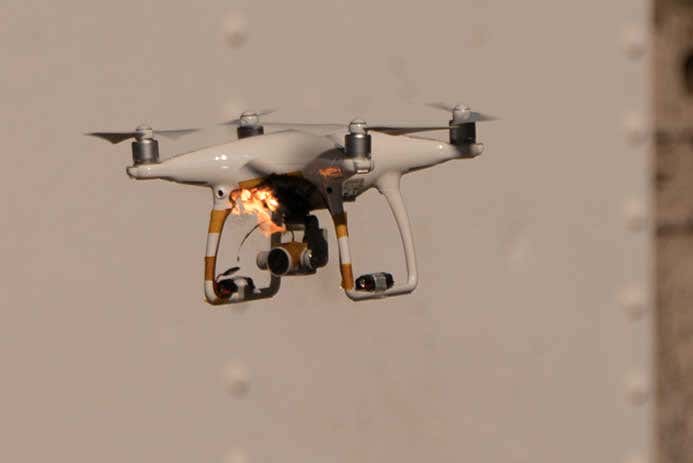
Raytheon Intelligence & Space's High Energy Laser weapon system mounted on a buggy seen disabling a small unmanned aerial vehicle during a test in New Mexico.
We have multiple techniques to overcome and sift through poor weather conditions, so it's less of an impact than one would think. We've developed a system that excels at electro-optically tracking very small targets in ground clutter because these drones are made to fly very low and in very difficult areas. Our system can often electro-optically track a low, slow-flying target, like a small drone, better than radar systems can. But severe weather conditions, severe fog, and severe humidity and moisture in the atmosphere, can degrade your track capability and increase your time to prosecute the entire engagement. That being said, our primary threat set right now, the small drone threat set, is also very reliant on electro-optical infrared sensors and not great at flying in very poor weather conditions. So most of the time you have a drone flying, we have the capability to track and destroy that drone.
In the worst-case scenarios, you may not be able to depend on the laser to finalize the hard kill of your threat. For that reason, we never advertise lasers as the end-all-be-all solution for an air defender. You want options and you want layers for different operation scenarios. But laser weapons are a key part of that layered defense. The Army has adopted this language. They call them ideal final protective fires assets.
About 80% of the time you'll be using the laser, which means you're on the right side of the cost curve. Your cost per engagement's small and your energy magazine is very deep. You also have the benefit of the sensor capability. But when the weather's really poor you might leverage the all-weather HPM or other capabilities, such as jamming or kinetic missile systems. One such kinetic missile system is Coyote, made by Raytheon Missiles & Defense, which is an optimized hybrid drone missile that's designed for killing drones for relatively low cost, and does so at very, very long ranges. Directed energy complements kinetic systems to create defense in depth.
Justin:
So, in terms of specific systems, can you give us an idea of the capabilities of Raytheon's high-energy laser weapon system (HELWS) and the latest iteration, HELWS2? What does it specifically bring to the table and how do you see a form of it operating on the modern battlefield going forward?
Evan Hunt:
We've been making iterative upgrades, rapidly prototyping these systems, and so each system we've built is a slightly upgraded version of the one prior. This has all happened in a very short time period. We started with software and fire control enhancements that just make the system easier to use, and have a big effect on how quickly you can prosecute an engagement. We use a gaming-style controller and a single laptop to prosecute the engagement.
We have multiple techniques to overcome and sift through poor weather conditions, so it's less of an impact than one would think. We've developed a system that excels at electro-optically tracking very small targets in ground clutter because these drones are made to fly very low and in very difficult areas. Our system can often electro-optically track a low, slow-flying target, like a small drone, better than radar systems can. But severe weather conditions, severe fog, and severe humidity and moisture in the atmosphere, can degrade your track capability and increase your time to prosecute the entire engagement. That being said, our primary threat set right now, the small drone threat set, is also very reliant on electro-optical infrared sensors and not great at flying in very poor weather conditions. So most of the time you have a drone flying, we have the capability to track and destroy that drone.
In the worst-case scenarios, you may not be able to depend on the laser to finalize the hard kill of your threat. For that reason, we never advertise lasers as the end-all-be-all solution for an air defender. You want options and you want layers for different operation scenarios. But laser weapons are a key part of that layered defense. The Army has adopted this language. They call them ideal final protective fires assets.
About 80% of the time you'll be using the laser, which means you're on the right side of the cost curve. Your cost per engagement's small and your energy magazine is very deep. You also have the benefit of the sensor capability. But when the weather's really poor you might leverage the all-weather HPM or other capabilities, such as jamming or kinetic missile systems. One such kinetic missile system is Coyote, made by Raytheon Missiles & Defense, which is an optimized hybrid drone missile that's designed for killing drones for relatively low cost, and does so at very, very long ranges. Directed energy complements kinetic systems to create defense in depth.
Justin:
So, in terms of specific systems, can you give us an idea of the capabilities of Raytheon's high-energy laser weapon system (HELWS) and the latest iteration, HELWS2? What does it specifically bring to the table and how do you see a form of it operating on the modern battlefield going forward?
Evan Hunt:
We've been making iterative upgrades, rapidly prototyping these systems, and so each system we've built is a slightly upgraded version of the one prior. This has all happened in a very short time period. We started with software and fire control enhancements that just make the system easier to use, and have a big effect on how quickly you can prosecute an engagement. We use a gaming-style controller and a single laptop to prosecute the engagement.
For this last system we're building for the Life Cycle Management Center, we're moving away from the dune buggy configuration, and we're taking that modular configuration and putting it into a palletized architecture so that it can be easily employed on the back of any commercial truck or on a building or tower.
Different customers want different vehicles. The Polaris MRZR's been a fantastic option just for easy transport – and it's loved by the armed force – but ultimately I think we'll end up putting laser weapons on a number of different vehicle types. So the palletized architecture was part of that.
Justin:
You mentioned magazine depth—to what extent does the magazine depth, in a continuous engagement context at least, degrade as you move down to smaller and smaller classes of vehicles? Because obviously often the ‘unlimited’ magazine depth is often put forward as one of the key advantages of directed-energy weapons, but that's usually in the context of a maritime or a fixed-based defense capability where you have a huge power source and lots of space for capacitors. So, how much of a trade-off would customers get if they're trying to move down to either a palletized form or even potentially those smaller dune buggy type applications?
Evan Hunt:
If you look at the amazing advancements in the hybrid and electric vehicles and the increased range in, for example, the latest Tesla's, it gives you an idea of the rate of advancement we've got in our lithium-ion battery energy magazine. The first system we built had enough energy magazine for 20 to 30 drones, for example, and now we have 40 to 50 drones-worth in a single magazine. Then you can just plug that magazine into any standard generator and recharge it in roughly half an hour. You have virtually unlimited power and, unlike other weapon systems like missiles or ammunition systems, you don’t have to transport the ammo.
Justin:
Hopefully, the adversary runs out of UAS before you run out of shots?
Evan Hunt:
That's the real trick. The biggest problem with the swarm is just how many targets there are. So, you can get overwhelmed, and that's why directed energy is so compelling.
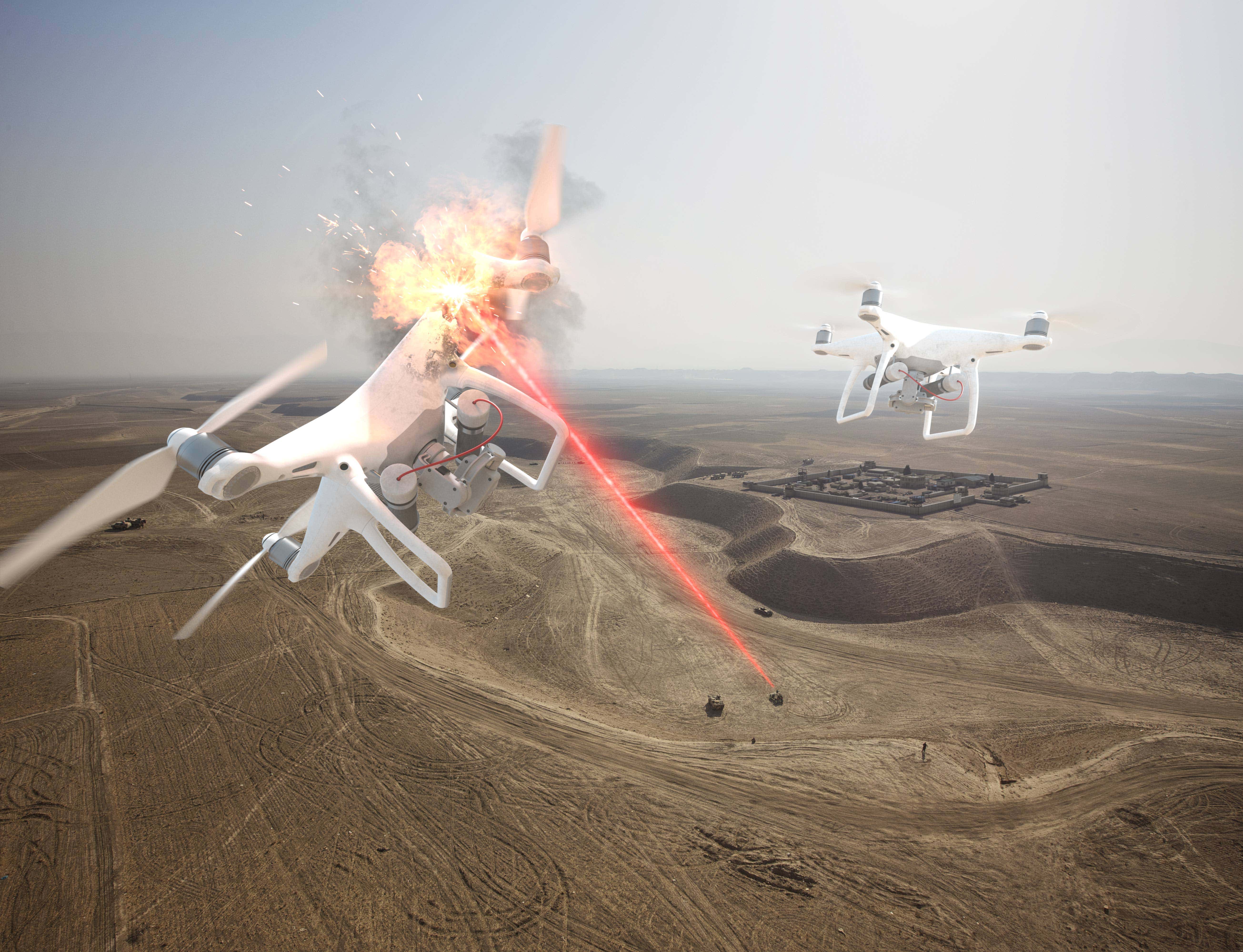
Justin:
High Energy Laser Weapon System 2 (HELWS2) seems to be squarely marketed at the counter-UAS mission, which you've mentioned a lot. It's clearly a very real concern at the moment, a very live concern to the militaries all over the world. Presumably, you've seen an active interest in this system from multiple service branches in the US, but also from international customers. What do you see is the overall market for this sort of system?
Evan Hunt:
I think there's a compelling multi-service and global market associated with counter-drone technology, and right now there's a technology race for what is the best counter-drone technology. You have everything from net-thrower drones to handheld jammers and larger omni-directional jammers, gun and missile systems, lasers and high power microwaves – all being developed and trying to prove their worth. In my view, the laser is, for a mature air defender, one of the most optimized solutions for a final protective fires mission. That’s because it gives you the positive identification capability you need. It gives you the hard-kill capability you need and it does so in a relatively undisruptive manner. You don't have explosions. Yet you can engage highly maneuvering, difficult targets even in clutter at tactically significant ranges. There are very few of those systems that I mentioned that actually meet all those categories. In fact, maybe none but HELs.
Justin:
On that subject, could the HELWS2 in its current form be capable of other SHORAD tasks that are currently covered by other kinetic systems such as C-RAM (counter-rocket, artillery, and mortar) against things like attack aviation, perhaps even counter-missile defense? And if not a system along the lines of HELWS2, what sort of directed-energy weapon systems do you envisage playing in that kind of mission set?
Evan Hunt:
We look at the laser market in a few different categories. This 10-kilowatt class is really a counter-small-drone market. A step up is the 30 to 50-kilowatt class, which is really designed for not only small drones at longer ranges, but also potentially Group 3 drones, cruise missiles, rocket artillery and mortars. For the US Army Rapid Capabilities and Critical Technologies Office (RCCTO), we've built a 50-kilowatt class laser weapon subsystem that's getting integrated onto a Stryker vehicle as a combat prototype for what could potentially become a part of the Mobile Short-Range Air Defense (M-SHORAD) program of record for a much broader target set than just drones.
Right now there's a tentative plan to build many more vehicles within the decade for the M-SHORAD program, based on Stryker vehicles, and the vision is that if our demonstrator which we're going to demonstrate this summer is successful, then a portion of the vehicle component will be directed-energy variants that carry 50-kilowatt class laser weapons on them. So the Army has adopted this same vision of a layered defense and a complimentary laser and kinetic capability, not just for drones, but for the full target set.
Justin:
Is the 50-kilowatt class laser on Stryker for the M-SHORAD project a fundamentally different proposal from HELWS2 and does it present its own new challenges, or is it very much a growth of the existing architecture on similar lines?
Evan Hunt:
I would say it's a growth. Part of what's made us so successful so far on the M-SHORAD development is that we had the ability to directly scale many of the pieces and parts from the HEL weapon system that we built for Counter-UAS. The lithium-ion battery technology is directly scalable. The fiber laser beam combination technology is directly scalable. The fire control architecture of the software is virtually the same. So, the only major thing that was a real step up was a larger class of beam director, which frankly is part of the same product family as the smaller beam director we built for the high-energy laser weapon system. We're talking about technology that has been proven overseas already, and now we're just scaling it up.
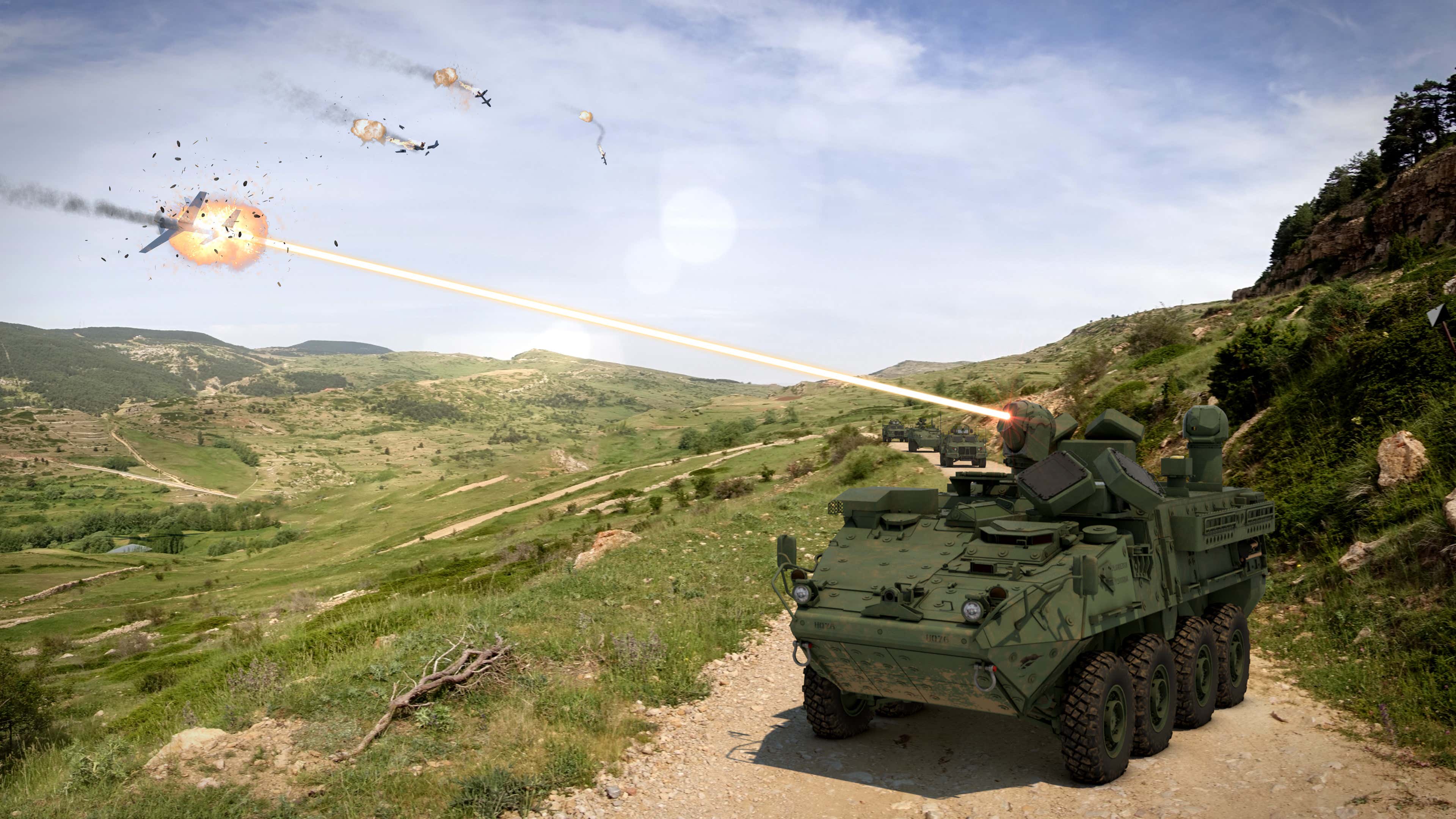
What are the similarities and differences between HELWS and the PHASER high-powered microwave weapon system? When do you want a laser and when do you want an HPM? And do you see these two types of directed energy complimenting each other on the battlefield, particularly when it comes to defeating drone swarms?
Evan Hunt:
The Army calls HELs serial killers, because they engage one thing at a time. I think of them as similar to a sniper rifle. When you're engaging something incredibly precisely, you use a laser. An HPM has the capability to emit a burst and disable a bunch of drones flying in a tightly packed swarm. So in certain operational contexts having both complementing each other makes a lot of sense. Both are compelling counter-swarm technologies.
I'll give you an example. You might have a few drones pop up from a nearby residential building that is flying near an airport tower or flying along a highway with commercial vehicles on it. In those types of scenarios, you'll probably want to use the laser because you don't want to disable certain other digital technologies. And in some cases, you're out protecting a forward operating base and you have a swarm coming in. Well, then it's kind of all hands on deck and you're going to use everything you can use and you don't have to worry about collateral effects.
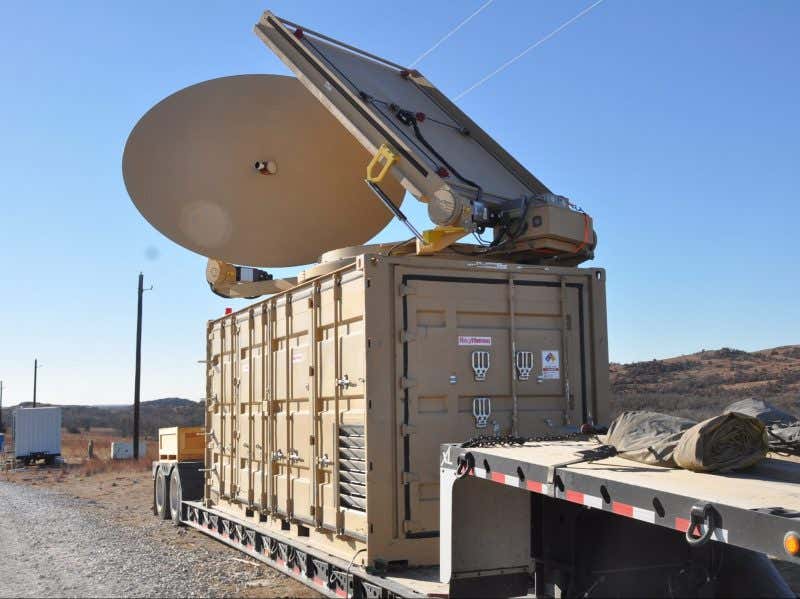
Justin:
Raytheon has been test-flying a HEL weapon system in a pod slung under an Apache’s stub wing. It's really the first we've seen of an airborne compact laser weapon on a rotary-wing platform. Can you elaborate on how you see, perhaps, attack aviation using such a system on the battlefield, and any updates that you might be able to give us on where that program stands and where it's going?
Evan Hunt:
We did a lot of testing under a cooperative research development agreement with the U.S. Army Apache Program Management Office and U.S. Special Operations Command to prove that lasers were viable for those types of platforms, such as Black Hawks and Apache platforms. By viable, I mean that they could survive under strong vibration conditions, that they could hold their aim point on targets despite those vibration conditions and despite turbulence. I think that was a very successful collaboration with the US government.
All the HEL subsystem technologies are advancing at a very rapid rate, so I would expect that there is a future for lasers in aviation. But I think our goal right now is to demonstrate on the ground first, and transition these technologies to production for both counter-UAS and M-SHORAD, and then we'll see what's next.
Justin:
On the naval side of things, where of course SHORAD and counter-UAS is also a big concern at the moment, there has in the past been some talk of creating a laser Phalanx. So, you'd use some of the proven close-in weapon system’s sensor and aiming components, and then pair that with a HEL rather than the 20mm cannon. Is this still a potential concept, and where do you see directed-energy is best applied in the naval domain?
Evan Hunt:
The Navy is very serious about higher power high-energy lasers on service Navy platforms. They aren't just concerned with drones though. They're concerned with the full target set, like the SHORAD target set or even higher power. I think ideally the Navy wants to be able to deal with all their threats with the laser. Raytheon has focused to date on moderate power systems that can be transitioned most quickly to the warfighter, but we are now turning our attention to higher power systems
The Navy was also really the first program office or first element of the DoD to invest heavily in getting a demonstrator overseas, and that was the USS Ponce demonstrator. It was a 30-kilowatt class system, and from there they moved out pretty quickly with a few programs to build greater than 50 kilowatt systems on ships.
Justin:
There has also been discussion around using laser weapons for defense both in naval but also in a land-based context against really high-end targets, particularly ballistic missiles. Do you see either HEL as promising technologies for defending key targets against ballistic missiles specifically during terminal attack phases?
Evan Hunt:
Well, in the early 2000s the Department of Defense built something called the Airborne Laser program. The DoD invested a lot of money and we did build a megawatt-class laser weapon that was capable of engaging target sets like that at significant range. It wasn't packaged in a form that was really logistically viable, but a lot of the developments we've made in recent history draw upon industry expertise that was developed in those days.
I think at a theoretical level, laser weapons and directed energy, in general, make perfect sense for high-flying fast targets, ballistic missiles or maybe even supersonic threats. If you have to engage targets in a cost-effective and precise manner, and even targets that are flying faster than the speed of sound, where you might even have to engage them from behind…well the best way to do that is with an effector that moves at the speed of light.
But we have a long way to go. We have to demonstrate that we can build laser weapons of a sufficient power class in logistically viable form factors that are capable of dealing with those target sets. Our approach has always been to prove we can deal with the less complex threats first, and prove that the laser weapons are ideally matched for those. Then that technology will transition into higher-powered developments for the other target sets.
Justin:
You mentioned the advantage that HELs have in the targeting process, in the fact that they are essentially optics and can continue to function in that role while being HEL effectors. What approach is Raytheon taking to HEL in terms of the challenges of integration within the broader recognized air picture, and within the sensor-shooter targeting architectures that both the US Air Force and the broader DoD are trying to set up?
Evan Hunt:
Our whole goal has been to deliver a weapon system that is mature and capable of fully integrating with DoD customer architecture. We actually have already integrated the HELWS with established mature baselines for Command and Control. So our systems are already integrated and feeding that integrated air picture now.
We also team very closely with the KuRFS radar business unit within Raytheon Missiles & Defense. K-band radars have a lot of fantastic capability for detecting and tracking small drones. So, many of our systems have been delivered and are actually being used with K-band radars on the network right now.
Justin:
Coming to the end of the interview, one of the outstanding questions I had was; what are the main challenges and roadblocks that you see still outstanding between where DEW is today and a future where DEW is a commonplace weapon system seen on the battlefield in the various domains?
Evan Hunt:
There's been a lot of focus within the Air Force and the Army on building combat prototypes. That has allowed us to really build with ingenuity at Raytheon, where the folks building the system can make the appropriate trades internally to not just have a beam fire for a certain number of seconds, but to ensure that the whole system that's delivered to the warfighter, is as optimized as possible. There has been great progress from the Department of Defense acquisition strategy to allow this technology to move forward by building combat prototypes that aren't so specific in their requirements.
At the same time, the HELWS – a full weapon system that is in the hands of operators – was developed on Raytheon’s internal investment. So, when we have robust funding profiles and outlooks for transition of production, the entire industry supply base will have the security they need to make big investments and to drive the technology forward.
I think the biggest roadblock remains funding. Although a lot of money has been invested in laser weapons, it pales in comparison to the DoD budget as a whole. If we're very serious about directed-energy technology being a key part of national defense strategy and getting on the right side of the cost curve and dealing with asymmetric threats, then we need to get serious about the transition of the technology. I think the Army and the Air Force have been, together with Raytheon, leading from the front in that regard.
Justin Bronk
